10-24 March 2017
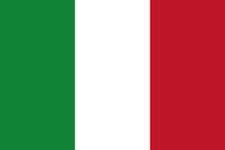
| Italy 10-24 March 2017 |  |
Italy has called to us for a long time, and Marisa had made her first trip during her study abroad time in 1982, getting some good experience for not much money, but wishing she could have dug deeper, stayed longer. Our first plan for a trip there together came in 2001 when we bought plane tickets and were set to go in November. But only a few weeks after the 9/11 attack, the U.S. State Department still had a travel warning posted for many countries and we felt compelled to postpone the trip.That, alone, is one of the reasons that any of the world's population is lucky to get to travel.
For the history of Europe, its people and their descendants who have landed around the world, there is no greater single influence as lasting and as deep as that of the Roman Empire and the Catholic church that followed.
AND, they make pizza, opera, chianti and . . .
We have to go.
Thursday-Friday, 9-10 March
Landing before 10am, we are met after Customs by our driver from the hotel and swept away in his oversized van through increasingly narrow, jutting and curvy streets of cobblestone, aggressive pedestrians and scooters, dodging combative cars, soon landing safely at our Hotel Condotti. Only 15 of those 20 minutes from the airport flirted with the chance of some kind of Fiat inferno. . . There is no better way to be baptized in the traditional riskiness of Rome, the ancient and the fresh. Ciao!!!
Immediately after checking in, we take a five-minute walk -- yes, just five minutes -- to the Spanish Steps, mixing with the wandering, sometimes assembling, crowds. These eighteenth-century steps -- this meeting place, this scene from Roman Holiday -- climb a steep slope from the Piazza di Spagna and link to what was the Bourbon Spanish Embassy. We are here. VENI!
We stroll back toward the hotel for our jet-lag-adjusting two-hour nap, pausing and staring into the shops shops, bars bars, restaurants restaurants, already aware that we had better watch for the delivery trucks and scooters, even on tiny streets. Our hotel room, though old-school small, has a nice layout with a king bed, well appointed Euro bathroom and a double window that opens onto the street -- the Via Mario de' Fiori.
Back out on the street after our rest, passing more crowds and cathedrals, the Pantheon is but a few minutes away for us. Group tours and individuals are managed well, and we enter the building quite quickly. As soon as one looks up, that's when the exceptional status of this treasure strikes.
The Pantheon is one of the best-preserved buildings of ancient Rome. It has been in continuous use since its commissioning in 27 BC and dedication in 126 AD. It probably survived the fate of many buildings by having been used as a church since the seventh century. One enters through a rectangular vestibule into a perfect circle -- the inspiration for Florence's Duomo -- with a coffered concrete dome and central opening (oculus) to the sky. Two millennia later and this is still the world's largest unreinforced concrete dome.
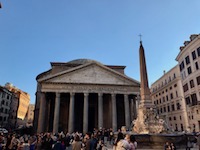
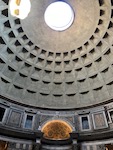
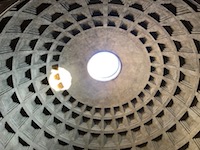
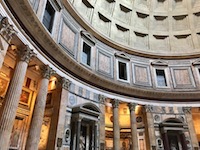
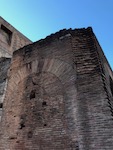
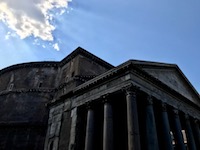
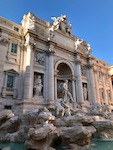
On our way back to the hotel, we easily walk by the Trevi Fountain, centerpiece of another piece of movie fluff: Three Coins in a Fountain. The fountain marked the ancient terminal point of three roads and an aqueduct that supplied water to ancient Rome. Now a Baroque riot in stone, it was finished in the seventeenth century and today serves as a coin magnet (3,000 Euros each day) for those who want to guarantee their return to Rome another day. We see huge, happy collections of visitors from all over the world, impossible to firmly distinguish one from another. This is a welcome mixing of strangers who appear, today, to have curiosity and cultural appreciation in common.
Close to the hotel a short time later, Antica Enoteca is our restaurant for dinner. Wine, meats, cheeses and bread to settle us into this: the next part of our world we will explore together.
Saturday, 11 March
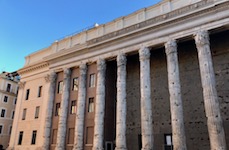
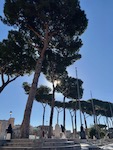
Easy breakfast at the hotel, served by a lady speaking great English, who, when asked how, says she's Romanian and has several languages. Warm talk and meal giving us a laughing start to the day.
One mile away is the Colosseum, so we saunter over, under clear, blue 50-degree skies. Naturally, every stop of the way, there appears an old, very old or ancient structure. All the way, the streets are rather empty, and we reach the crowds only when we near the Roman Forum and make our way to the entry lines for our destination. Perfect sky and ancient spectacle take us back in time as Marisa reads history and descriptions out loud for us as we walk up, down and around.
Another concrete masterpiece of Roman architects, the Colosseum was completed in 80 AD and could hold up to 80,000 spectators. Gladiators, executions, wild animal killings, and even mock sea battles on a flooded floor were on the agenda. Over the centuries it was damaged by fire and earthquakes, turned into a cemetery, housed a castle and a religious order, and finally endorsed as a place of martyrdom in 1749. Now beautifully restored and secured, it's a perfect and chronological second stop after yesterday's visit to the Pantheon.

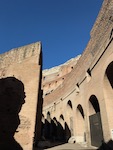
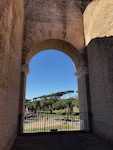
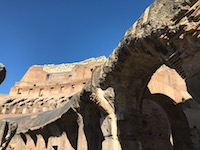
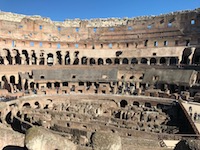
From an upper level, we look out at the Palatine Hill and the Roman Forum. Our next stops.
The Palatine Hill is the centerpiece of Rome's Seven Hills and looks down upon the Roman Forum on one side and Circus Maxiumus on the other. The hill has been a human home since the tenth-century BC and also the site of Rome's first imperial palaces (yes, Palatine is the etymological origin of "palace"). Augustus built his first palace here and the others followed.
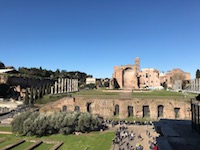
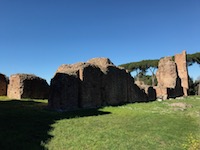
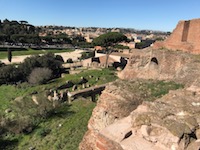
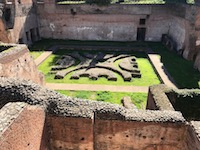
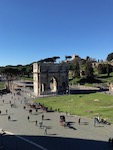
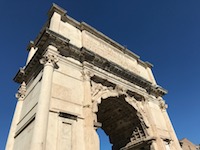
Winding down the hill, we enter the Roman Forum from the south, near the Arch of Titus. For centuries, starting in about 800BC, this was the center of Roman public life: parades, elections, public speeches, temples, places of business. Cicero famously denounced the Catiline conspirators here in 63 BC; Julius Caesar was assassinated here in 44 BC; and then after the fall of the empire -- over the course of a few centuries -- the buildings collapsed, the site decayed, the ground level rose, and all was covered by earth. Excavations began in earnest in the late 1700's. It is simply a breathtaking place.
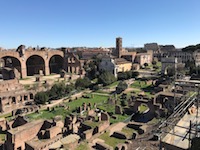
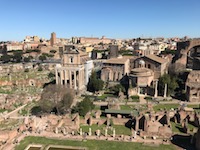
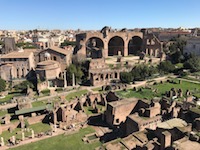
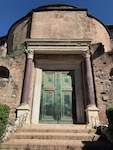
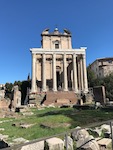
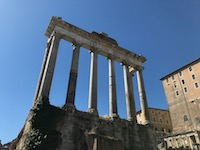
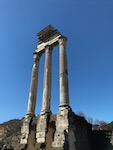
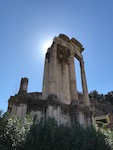
Making our way up to today's street level, we climb loads of steps to the Capitoline Museums. This grouping sits atop the Capitoline Hill, the tallest, smallest and now most important of Rome's Seven Hills, the home of government offices.
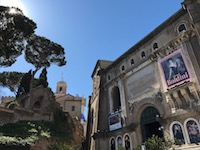
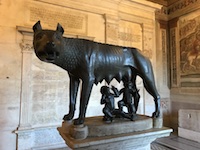
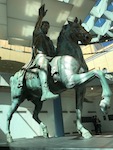
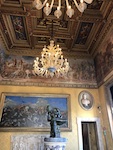
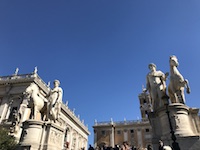

Within the museum, we have lunch up high in an enclosed event space with heavy, clear, solid, wind-breaking plastic surrounds. Breezes gently move them, and the view is good. The food is agreeable, and only a couple of pigeons make it to the table beside us. As we finish our time here, we are winding down five continuous hours of filling our eyes with the amazing, still-visible, if sometimes crumbling, history and pieces saved or recovered for the museum. Walking back to our hotel neighborhood, we plan for a little rest and some more reading before our dinner at the same pleasing restaurant as last night.
This time, there is a crowd around the bar, speaking lots of English and shouting while watching a rugby match on TV, where the English team is setting a record winning streak. Our meal is, nonetheless, very pleasant, even as the full evening meal crowd keeps coming and fills the place beyond capacity.
We then take a walk -- along with huge numbers of others -- on a pedestrian-only stretch of street that leads to the Piazza del Popolo. It lies just inside the northern gates of Rome and, before railroads, was a medieval European's first glimpse of Rome. Marisa had begun reading Goethe's Italian Journey at the airport and was just finishing up the chapter where he arrived at this very Piazza. Right here. Right. Here.
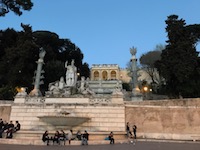
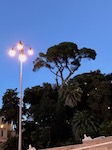
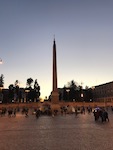
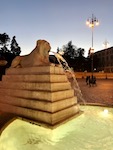
So many people of all ages are in the Piazza, many in teens and early twenties, plus street performers, to use the term loosely. They are selling bubble-makers and little flying copters and, as everywhere we have walked today, selfie sticks for mobile phones. Well, we learn that walking and gathering and milling about at night is even more of a "thing" than all we have seen during the day.
Nice night.
Sunday, 12 March
Breakfast and cab to Aqueduct Park (the Parco degli Acquedotti), first to just absorb the magnitude of the water system of the ages -- examples of which are all over the huge Roman footprint across Europe and around the Mediterranean. We start from the Aqueduct Claudia, on the east side.
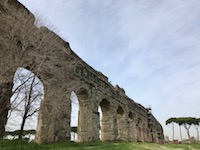
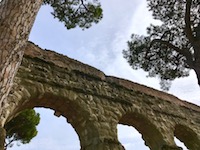
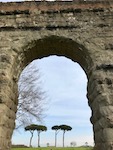
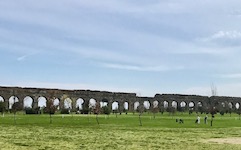
A golf course sits to one side with a fair number of Sunday players. We continue our hike that takes us to Appia Antica, the ancient, fourteen-foot wide, stone covered, amazingly straight and level "freeway" that stretches from Rome to Brindisi. The longest section was completed in 312 BC and, another movie reference, after the defeat of Spartacus, 6,000 slaves were crucified along the road from Rome to Capua.
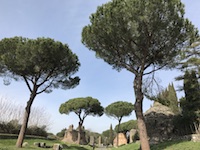
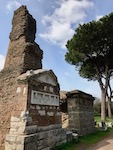
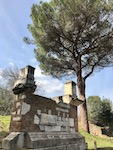
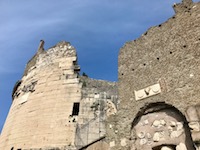
We walk on the mixture of large, ancient stones and smaller ones added over time, dodging bicycles and the occasional car, which we had read was banned from this stretch. We stop on rock remnants for rests and to look around, just being here. At one point, we have our picnic in the shade of the umbrella pines on this, yet another day of clear, blue skies.
About five miles into our walk, after passing multiple private drives with huge fields, fences and security gates -- and maybe a mansion down or up the hill -- we stop for cold beverages at the Antica Caffe. Outside tables on the ground, open space with canvas cover and lots of relaxed people.
From there, as we walk toward our stopping point near the Domine Quo Vadis (yes, yes, another movie reference) the pedestrian space is cut to barely enough for one person, and many cars whiz by in both directions, causing us to involuntarily dodge sometimes. Not what we had read to expect. We stop at a small, open public building where an attendant calls a cab, and we are soon at our next destination: the cathedral of St. Peter in Chains.
We wait on benches out front for the 3pm opening, a crowd gathers, including a group with clearly American speech, filled with multiple races and ethnicities. A pleasing reminder of the small world of which we are a part.
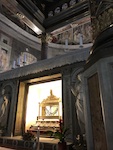
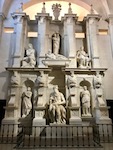
The basilica was rebuilt on older foundations in the early 400's to house the chains that bound St. Peter when he was imprisoned in Jerusalem. But we are here to see Michelangelo's Moses. Originally intended as one of the forty statutes commissioned for Pope Julius II's tomb (Agony and the Ecstasy, anyone?), this is a masterful and muscular piece. This is Moses infuriated, having coming down from the mountain with the ten commandments in hand only to find those Hebrews prancing about with a golden calf. Oh, yes, and a remark about biblical inerrancy: check out Moses' horns. St. Jerome translated the Hebrew word keren to describe Moses' face. Keren can either mean radiated or... grew horns. You make the call.
We cab it back to the huge, boisterous and happy mob at the Spanish Steps, the seated Sunday crowd of happy humans covering the steps. After our stroll back to the hotel and our nap, Wade goes out and brings back a good dinner, then goes out again for gelato. There, he has a long conversation with an Albanian (excellent English) who has a cousin in Norway, where Marisa's ancestors are all from and where we have family contacts now. Interesting connections, sometimes, when we ask questions and listen to answers.
Then, after dessert, reading up and writing down this, in anticipation of tomorrow's icons: The Vatican and the Sistine Chapel.
Monday, 13 March
Most museums are closed, but the Vatican is open. And that means there will be crowds. Oh, well. We have timed, pre-purchased tickets to the Museum and we'll just have to wait in line with everyone else to get into St. Peter's.We walk on yet another stunningly perfect morning, slowly by the river, to the separate nation of 110 acres and a population of 842. Vatican City was designated an independent state in 1929, meaning that it is not subject to any other nation, including Italy, even though no passports are checked upon entry.
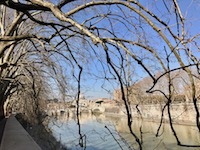
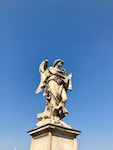
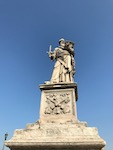

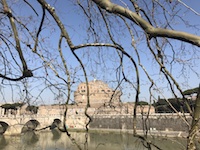
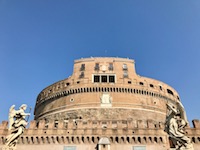
Today, we describe only the crowds, the setting, and the scenes. The art and the history are above anything that we may evaluate or review. This is, of course, an essential experience when fortunate enough to be in this part of the world. Thousands of people. When we join the line at 9:45am, ours is for individuals, and another next to us is for groups. Though well wrangled, both are massive collections of patient and historically curious or religiously faithful people from across the world.
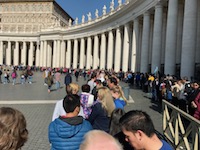
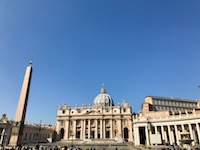
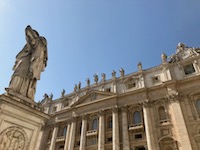
After nearly two hours, we pass through the one security gate that is open (out of nine we count) that is for individuals. Of course, it is worth the effort and the wait. The full facility, on the INSIDE, can hold 60,000 people.This basilica was built on the foundations of the older fifth-century St. Peter's. Finished in 1626, it is a Renaissance masterpiece. (How many times can we describe something as a masterpiece in this city?) The side chapels are as big as churches themselves; Bernini's altar is nearly ten stories high.
We spend a bit less than an hour here, but easily surrender to the gravity and the forceful intimidation that comes from the sheer size and ostentatiousness of the architecture. Then there are the peaceful moments that come with approachable, flawless art -- such as Michelangelo's Pieta. All is here for the ceremony and the celebration of assumed power and manifest belief.
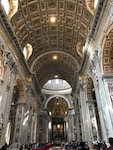
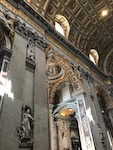
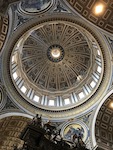
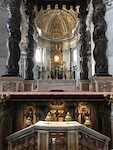
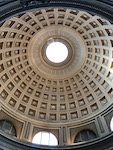

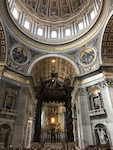
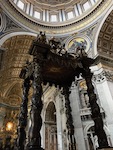
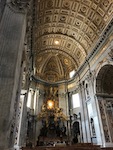
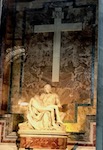
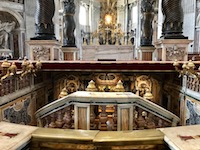
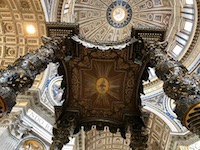

We exit and make the long loop around to the entrance of the Vatican Museum. Even with our pre-purchased tickets, we join more crowds of tour groups and individuals jostling for viewing positions. Without exaggeration, these are the thickest mobs we have joined in all our travels, together and individually. And this is not the busiest tourist or pilgrim season.
There are 54 galleries, 640 employees, and 20,000 (of the 70,000 works) on display. This is not for an afternoon. But planning ahead helps and we pick and choose our way among the rooms. Although many (most?) come to giggle at the fig leaves and stare at the ceiling, we spend a bit of time with the oldest sculptures. The Vatican Museums get their start with Pope Julius II (him again) who builds it around a sculpture of Laocoon and his Sons that had been discovered in a Roman vineyard in 1506. Michelangelo goes to examine the discovery and it's put on display a month later. Marisa's last visit to the Sistine Chapel was in 1982 when a good chunk of it was covered in scaffolding and the other pieces were sooty and dulled. It's something to behold. But the crowds are jostling, the elbows are poking, and the multilingual guides are shouting.
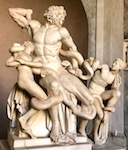
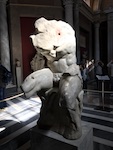

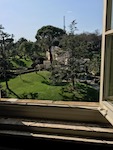
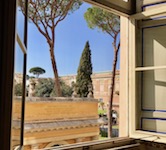
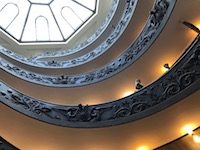
Walking back to our neighborhood, immediately back on the Rome side of things, we choose another path that will take us to the Piazza Navona. It's another narrow, rolling, stone path lined with jewelry stores, small restaurants, art and relic stores. One artist, with his portable display set up on the street side, catches our eye, and we buy a piece that shows the very walk by the river we took this morning.
Now to Piazza Navona: a first-century AD rectangle built on the site of Domitian's stadium. Several famous fountains are splashing: the Fountain of the Four Rivers is at one end and the Moor's Fountain at the other. We land in a small restaurant right in the middle. We sit outside as the sun is sinking behind the buildings across the piazza from us. As we have our Prosecco, martini and (first for us in Italy) fabulous pizza, a guitarist sets up fifty yards from our spot and plugs in. He plays his electric, no-vocal with an excellent jazz-rock feel, using a pre-recorded background. Among others, "Sultans of Swing" by Dire Straits.
The unexpected, comfortable and music-covered dinner venue gives us a sweet end to a full and important day for us in these two independent nations -- Italy and Vatican City.
Tuesday, 14 March
Today is the bus ride to Pompeii, and we take a cab to the pickup location for the prepaid trip. Our lady guide confirms, once we are all seated and the driver pulls out, that all on the bus but one couple, are English speakers. The couple in their thirties across the aisle from us is French. (On the way home, hours later, Wade tries out his French language skills attained, such as they are, from his time at University of Dijon in 1970. The warm conversation is worth the effort.)The bus is a pleasant way to be taken through the countryside, past Naples with the Isle of Capri visible a short way out in the Mediterranean.
Pompeii's story is, of course, well known because of its sudden demolition by an eruption of Mt. Vesuvius in 79 AD. The devastation is evident in the architectural remains we pass on street after street.
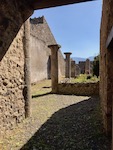
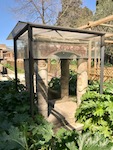
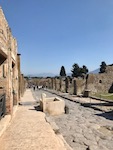
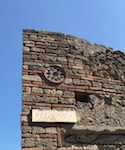
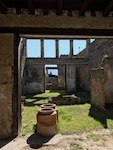
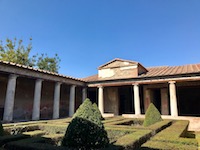
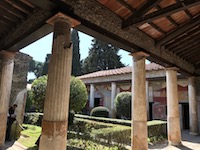
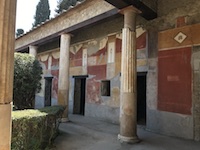
But the vitality of that time and that city is also visible in the vast number of identifiable artistic and design elements that now show after centuries of meticulous excavation.
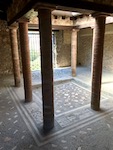
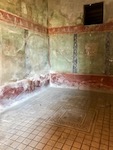
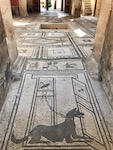
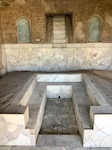
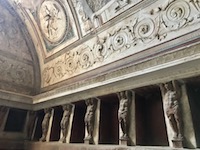
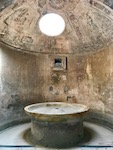
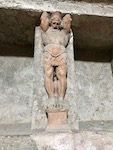
Winding through the vast expanse of evocative ruin, we find ourselves thinking less of the death and more of the life of that city -- what it was like to go to a family gathering with the frescos on the wall, or to the arena for brutal sports of the day, or what the "she-wolf" calls of prostitutes (as described in our guide book) meant to the residents.
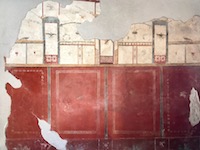
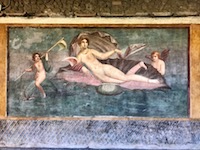
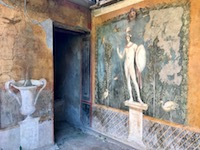
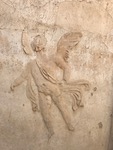
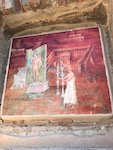
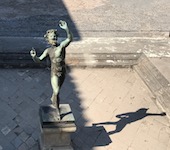
The size of it, and the way Pompeii is alive today in so many ways -- these are moving surprises from this worthy trip.
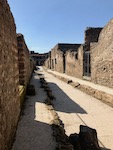
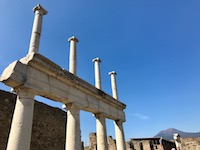
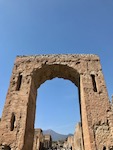
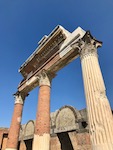
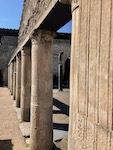
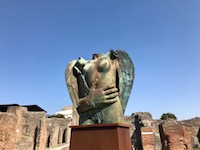
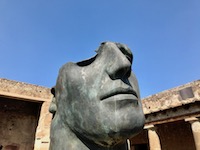
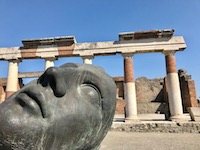
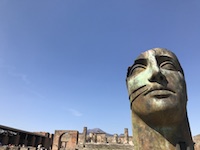
Arriving back in Rome, we taxi to the restaurant near the Piazza del Popolo recommended in private conversation with our guide earlier today. Osteria St. Ana is the kind of restaurant that sits a half floor down from street level with lots of homey decorations on walls and petite chairs and tables jammed in, four male waiters moving quickly, squeezing to and from the kitchen.
We love the food and savor our earned relaxation, staying well over an hour to celebrate another perfect day. We are working so hard.
Wednesday, 15 March
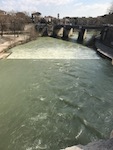
For our last full day in Rome we walk and look about for miles again, almost taking for granted this scooter-walker-taxi-delivery truck-narrow-to-nonexistent-sidewalk world.
First stop: The Jewish Ghetto. Yes, the Romans (specifically the Catholic-controlled government) established this walled compound in 1555, locking up at night the 2,000 Jews, whose community here predated Christian times. Life in the ghetto was generally one of crushing poverty and humiliation. Like so many other places in so many other cities, Jews were not allowed to own property, but were given free rein to be pawnbrokers, sometimes bankers, but always under government control.
We continue across a bridge on the Tiber river that runs along this area, reaching the tiny island in its center. Here was the original gathering point some 3000 years ago for other peoples who would eventually form Rome itself.
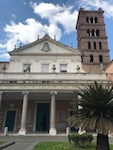

Across the river and into the Trastevere section of Rome, we visit some churches here, one with a Michelangelo sculpture censored with an added fig leaf, and one with St. Cecilia's statue in the base of the altar. Santa Cecilia in Trastevere is a fifth-century church built on the site of a third-century church that tradition says was built on the site of St. Cecilia's house. It's a beauty.
Lunch meal, outside. Meats, roasted vegetables and cheeses. After we sit, the place quickly fills, and the one woman out of eight people at the table next to us keeps her cigarette going the whole meal. It's a free country!
Rome has been so easy, active, welcoming and normal. We were, it's true, in a good part of town, but the historic, the restored and the repurposed structures emphasize the lack of gratuitous high rise architectural intrusion. There is ready access to authentic culture and cuisine and the mix of citizens from around the world.
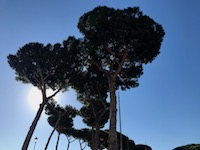
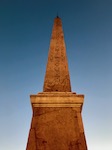
All of this makes it easy to imagine this a place to land for a lifetime. Though the aggressive street navigation culture can be daunting, adaptation is surprisingly quick. It is what it is, and each gets angry to one's own degree, but we saw and heard fewer angry exchanges than on a usual freeway afternoon in the U.S. At most, there is annoyed resignation.
Rome's age and beauty greet you with every step, and the enlightening mystery of its continuous 3,000-year history is in every breath you take.
Thursday, 16 March
Easy exit after breakfast and goodbye to the hotel and staff, saying, "Arrivederci, Roma!"We board the high-speed Trenitalia train at the active, up-to-date Roma Termini, and are off for a 1.75 hour ride to Florence. Inside the train our cushy seats are across from each other with a table between us, and outside is the rolling countryside. Having ridden Amtrak several times recently in the U.S., we are kind of stunned by the comfort, modernity and speed of this 21st-century transport.
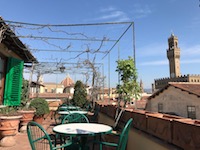
Walking to the taxi queue, we are waved over by a young female driver with good English who gets us easily around all the stone-covered one-ways to our fine Hotel Hermitage, very near the Ponte Vecchio, a bridge to even more of this phenomenal city of history. The ride, the views and the people feel very much like the Rome we just left. Nice.
The hotel reception is on the second-highest (5th) floor, and we are on the very top, sixth floor, looking out over tiled rooftops, the Palazzo Vecchio on one side, the Ponte Vecchio on the other side. Upon checking us in, the clerk offers us drinks on the rooftop garden, a few steps away from our room, where there are outdoor chairs and tables and trees and blue skies. She brings the drinks and some potato chips and peanuts in a single bowl, an Italy snack, it turns out.
After a quick rest and some other bites on the street, we go to the Uffizi Gallery, passing all the people who did not get advanced tickets as Marisa did. Here are priceless works housed in the old offices (uffizi) of the Medici family. Cosimo the first Grand Duke planned to display his family's fine works of art and his descendants carried out the work. The last Medici heiress, Anna Maria Luisa, willed these pieces to Florence. Some sculptures went to the Bargello Museum, but the best of the best Renaissance paintings stayed in the office building.
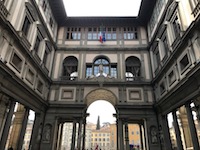
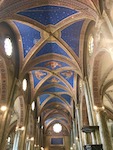
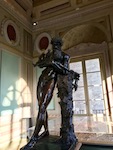
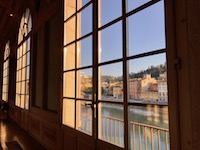
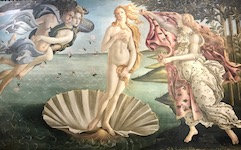


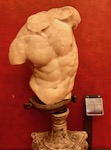

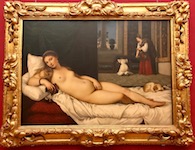
For an evening meal, Wade roams until he finds the Prosecco and pizza to go, passing many high-end retailers in small spaces and many restaurants, but not the small grocery like the one he used repeatedly in Rome. We'll figure it out another day.
Another good day. Another nice room. Another nice sleep.
Friday, 17 March
One year ago we were in Galway, Ireland on this saint's day. Today, we continue in Florence surrounded for another day with the images -- carved, drawn or painted -- of saints, saints, saints. And the occasional well-connected scoundrel who ran the country during its height of wealth and power.We have, today for the first time, a personal guide for the entire morning. We begin this excellent tour from Context Travel (http://contexttravel.com) at the Church of San Marco, the Medici family's early church. Cosimo the Elder founded one of the first public libraries in the world here, now holding some of the best works of Fra Angelico. Cosimo, in his remorseful older years, also kept a private monkish cell here.
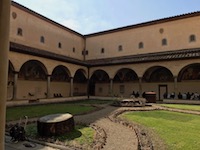
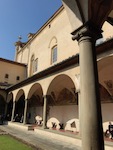
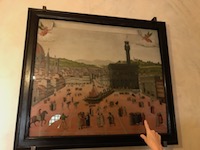

Down the street to the Medici's Riccardi Palazzo, then a side trip to a Benedictine convent for two more versions of the Last Supper. Both are laid out as is Leonardo's, with some occasionally aggressive imagery, including Judas as a dark-skinned Jew in stark contrast to the tall fair-skinned, good-guy Jews who make up the remainder. We finish at the unfinished church of San Lorenzo where Michelangelo's sculptures decorate two Medici tombs.
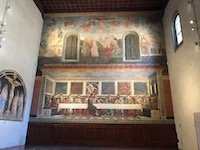
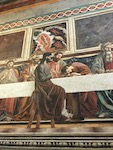
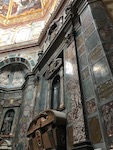
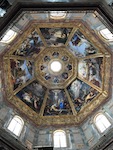
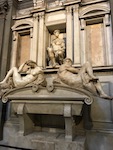
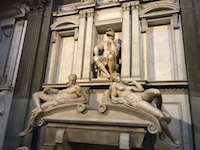
The central, recurring topic of our tour is the rising, falling, rising and falling again of any number of the Medici family. Commissioned art abounds, placing rich family members in the same rooms with anointed saints who never lived here, conflating the images of suffering, selfless men with those of the privileged, monetarily anointed kingdom-owning pedant.
Our guide is capable, knowledgeable, funny, relaxed and hails from Pennsylvania, having moved to the Italian countryside twenty years ago with her Italian husband, whom she met in the U.S. With a farewell moment of drink and debriefing, we come away feeling sated and relaxed in a way not often available in our usual self-guided mode. Her experience, knowledge and appreciation of her subject are infectious.
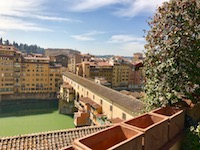
After lunch on our rooftop garden in the glorious sun and breeze, we ease across the Ponte Vecchio to the Pitti Palace. Originally owned by Mr. Pitti, the Medicis scooped it up in 1549 and it became their chief residence. It's a severe architecture on a bit of a hill overlooking its vast gardens down to the Arno River. Over 500 Renaissance paintings are here in the Palatine gallery and we enjoy a less widely known set of Raphael, Titian and Rubens.
Having located a small, bustling grocery on this side of the river, we select our dinner and wine for another rooftop evening at our hotel, where we spend two hours as the sun sets and the breeze mounts.
Saturday, 18 March
Breakfast and an easy entry to the Accademia Gallery after turning in pre-purchased vouchers for tickets and getting ahead of others again. The two things we're looking for here are Michelangelo's David and his unfinished Prisoners. David is seventeen feet tall, made from a large block of marble that had been neglected for twenty-five years. Michelangelo carved it when he was only twenty-six years old. The replica stands in front of the Palazzo Vecchio, but this is the real thing. It is a marvel. Down the long hall are the Prisoners that remind us of the strength required to carve marble. These statues literally seem to be striving to free themselves from the physcial weight of the stone.

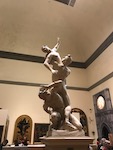

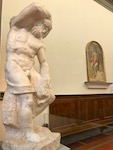
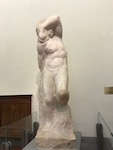
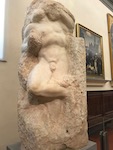
Now to the Museo Galileo close to the Uffizi Gallery and our hotel. The Galileo story is compelling, not least when we are reminded today, in the United States, that the deniers of science who have power will go to any lengths to express their power over the evidence of research. The materials held in this museum demonstrate how quickly and dramatically the pursuit of actual science advanced under the influence of a handful of strong minds in the face of such pre-emptive orthodoxy.
Galileo's scientific instruments are on display here along with beautifully done interpretations and helpful guideposts. Along with scientific instrumentation from all over Tuscany, here we see two of Galileo's telescopes and the lens he used to first view the moons of Jupiter. Oh, yes, and the middle finger of his right hand. These are all beautiful pieces of art themselves (except for the finger) and it's a nice change of pace. Not to mention, Marisa has finished the Goethe and so buys Galileo's Daughterin the museum bookstore. Recommended by our Context Travel guide, this will do nicely for the rest of the trip.
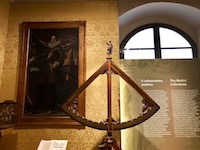
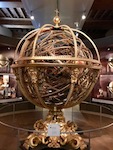
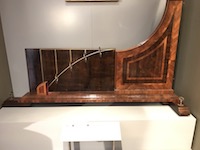
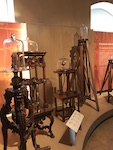
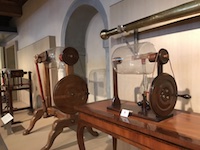
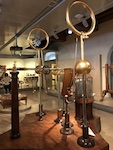
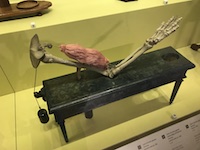
We have a wonderful lunch at a restaurant along the Arno, then head out for a spin through the museum of the Palazzo Vecchio. We're here more to see the building than the pieces in it. The Hall of the Five Hundred is magnificent and just happens to have two large murals by da Vinci and Michelangelo. The sculptures? All leaning toward violence. Naked violence.

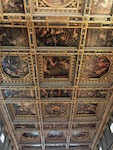
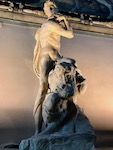
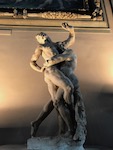
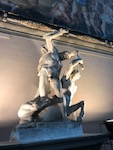
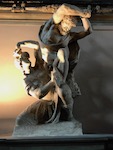

We spend a good bit of time on the second floor in the Hall of Maps which contains dozens of geographic maps painted on leather, showing the world as known to the Renaissance rulers.
We skip out on walking up the tower with a load of teenagers.
We stroll back to the hotel under cloudless skies.
A small supper of antipasti and prosecco.
Another evening on the rooftop.
We can see the tower from here.
Sunday, 19 March
Another unusual day (for us) in that we'll take our third guided tour of this trip. Generally, we've studied up and traveled only on our own, but -- without a car -- we've signed up for a day-long bus charter to Siena, San Gimignano and Pisa. Not sure if this is going to be a good idea or a bad one, we begin loading up at 7:30am near the train station along with 25 other English-only tourists, nearly all of whom turn out to be from U.S. or Canada. Our female guide, who welcomes us with humor and familiarity, is from San Gimignano, and kiddingly emphasizes her loyalty.
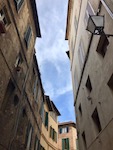
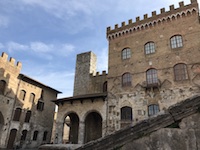
Sienna is a historic rival of Florence, having been overtaken and freed several times over centuries. It has been, and became significant as, a banking capital, and it was a destination for the best medical care during some of the world's worst epidemics. We wander through Sunday morning streets, blessedly few cars, lovely weather.
Because it's Sunday, we won't be allowed (as a tour group) into the Siena Cathedral (Duomo), but we DO get to see something we would never have done on our own: the museum in what had been until recently (1995) the Santa Maria della Scala hospital. Siena lies on the Via Francigena, the main pilgrimage road to Rome. And pilgrims get tired, and hungry and sick. Hospitals often grew up along these pilgrim pathways and this one dates to the twelfth century. What a stunner. Those pilgrims received free room and board in this place, which also served meals for the poor and the patients. The interior artwork is lovely, many of the pieces created after the fourteenth-century plague epidemics.
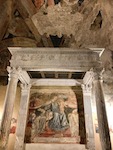
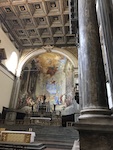
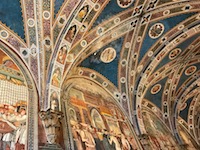
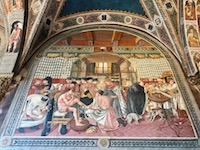

And then there is the Duomo. Built on a ninth-century church, the work on this one started in 1196. It would have been more than double its size if the second major addition hadn't been halted on account of the Plague. Again. It's a Romanesque design on the outside, but as fancy and swirly as any Baroque church ever dreamed of being. It's a pretty and delicious wedding cake of a church.
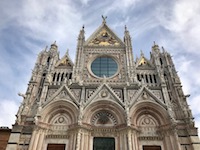
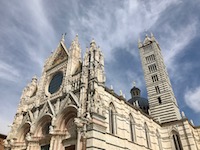
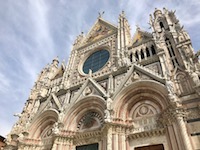
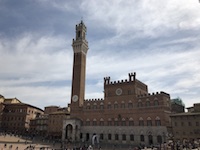
With an hour to spare before the tour group reconvenes in the Piazza del Campo, we head under cover for due cappuccini. Wade is burning his pate in the unexpected March sunshine, so he picks up a cheap cap at a street vendor advertising the Palio di Siena: the horse race, THE horse race. Siena is divided up into neighborhoods (contrade), each of which has a symbol: Eagle, Snail, Wave, Panther, Forest, Tortoise, Owl, Unicorn, Shell, Tower, Ram, Caterpillar, Dragon, Giraffe, Porcupine, She-Wolf, Goose. There are some moderately complicated rules about which ten contrade get to race every year on July 2 and August 16 (i.e. seven by right joined by three drawn by lots). It's wild, says our guide, and she's never been, even though she grew up just a few miles away. The specific-to-Siena guide who joined us for this morning is a Panther. Even if you move to another neighborhood, you never lose your birth designation. She says her husband is a Goose and each of her two children are something else again because they moved after they were married. So, yup, we just have a souvenir cap...
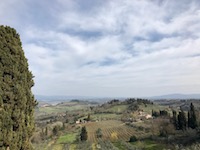
Included in our tour is a wine tasting and lunch at a winery in San Gimignano, one of the rare moments when we speak with other Americans on such trips. Civil and funny couple from San Francisco. No politics. So nice. The tasting and the lunch are good, and Marisa places an order for a case of their wine to be sent home.
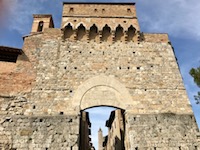
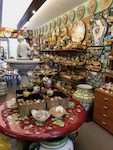
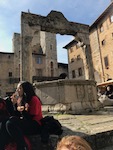
San G. ("san-jee"), as our guide calls her home town, is a medieval wonderland of towers and piazzas. We walk through the Porta San Giovanni at the southern end of the bouquet-shaped town and immediately begin to climb. And then immediately head into a porcelain shop for a Christmas ornament souvenir. Perhaps we were winded. So we climb again, this time up to the Piazza della Cisterna (a big fountain) and head to the place that won the prize for World's Best Gelato: the Gelateria Dondoli. It's good. We have a rosemary version and a vernaccia-flavored scoop. Vernaccia is the white wine grape most commonly associated with the San G. area and we had tasted a good bit of it during lunch...
We meander through the narrow streets, blissfully happy at the prohibition against mechanized vehicles in this town of towers. Up to the Piazza Duomo, but -- nope -- the cappuccino calls again and we sit and watch. Good thing, too, as Marisa has left that Christmas ornament in the gelato shop across the square and runs back to get it. Whew. Still there.

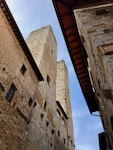
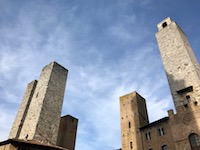
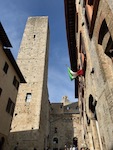
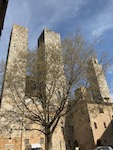
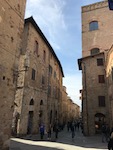
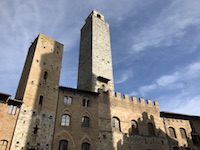
Pisa is our last stop, and it lives up to its mysterious fixation in the minds of all students of all ages. That tower. We have just under two hours here, but we really have no intention of waiting in line to walk up the crooked tower. (Truly, it doesn't just lean, it's crooked -- as if you'd stand a banana up on one end.) The sun is setting beautifully and the grass is emerald green. We walk into a corner bar looking out over the Field of Miracles and have a non-coffee drink. We ride back to Florence as the sun sets, full of appreciation for what we have experienced.
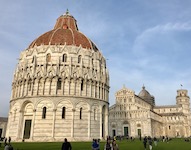
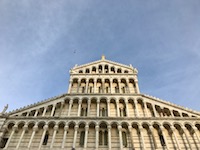
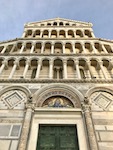
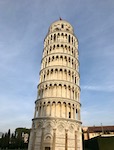
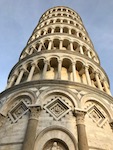
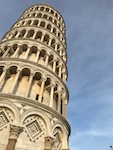
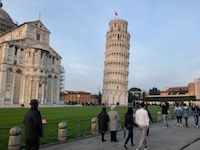
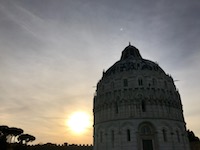
Monday, 20 March
The cluster of historic sites and museums invites us to the city center again. As on every other day of our trip, the mix of art and architectural history are layered upon each other. Today is Duomo Day.Started in 1296 (100 years after the Siena Duomo lays its cornerstone), this is the Renaissance masterpiece by Brunelleschi. And now we come full circle with the Pantheon in Rome: the inspiration and model for this most perfect dome. Which, in its turn, is the model for St. Peters and certainly the national Capital building in Washington D.C. Green and pink and white on the outside, but red, black and gold on the inside. (Incidentally, Marisa and her mother, Faye, have been picking out Italian floor tile for the guest bathroom up at the Minnesota farm. Italian cathedral floors are on our mind.)
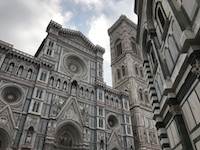
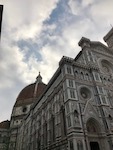
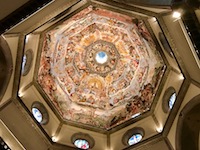
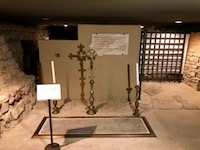
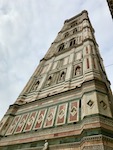
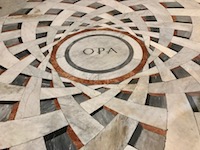
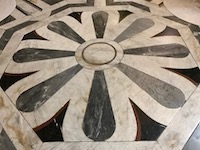
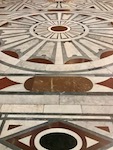
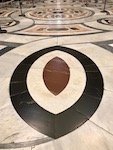
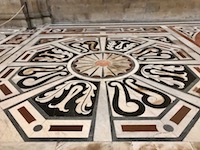
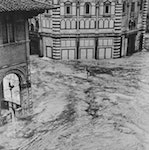
In 1966, the Arno River rose twenty feet and flooded the Duomo, damaging more than 6,000 volumes of documents and more than 50 illuminated manuscripts. Marisa descends into the crypt to look at archeological treasures, some uncovered during the renovation and restoration after the flood. Then up the tower steps with her pre-purchased ticket to get a better look at the Florentine vista. After a cappuccino break, we enter the Baptistry and gaze at the magnificent ceiling.
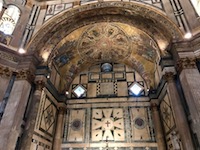
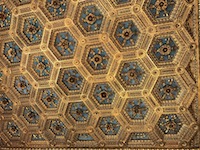
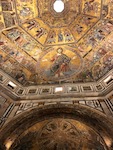

The famous Baptistry doors are replicas, but we see the real ones soon at the Duomo Museum. We think many people must leave this off their rush through Florence, but it's worth the stop. Truly, the doors alone are worth the trip, but they stand among glorious sculptures in the large gallery space: a literal recreation of the old cathedral facade. Donatello's penitent Mary Magdalene looks as if it were made for the twenty-first-century sensibilities of more modern art. And then we have another Pieta of Michelangelo's. This one with Nicodemus looking on -- most say this is a self-portrait of Michelangelo in his last years.
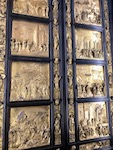
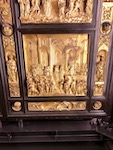
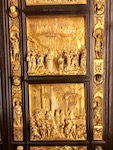

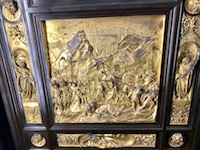
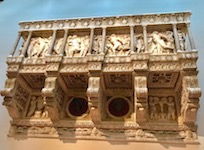
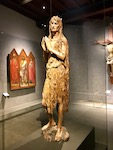

For a cultural kick, Marisa has scheduled a cooking class for the evening. We arrive a few minutes before it starts, and we are soon surrounded by 16 other English speakers from U.S., Canada, England and Scotland. The group is divided to work at four prep tables, and our partners are two ladies from Massachusetts. The instructors and staff are very good at keeping the laughs going as we amateurs chop, stir, roll, dust and season four courses of a meal that we then consume in a wine cellar beneath us.
For the second time in two days, we are at a table with English speakers, enjoying the food, the wine and the place we've chosen. Quick highlights and autobiographical stories fill the air. The techniques shown and the meal we produce is pretty good. The whole thing, including the break in our routine, is quite relaxing and very satisfying.
Tuesday, 21 March
More Michelangelo, Donatello and other significant artists in yet another of Florence's museums: The Bargello. And the building itself is another museum on its own. Begun as a Renaissance palace in the thirteenth century, it was built to house the first mayor of the Florentine City Council. The oldest public building in Florence, it was actually the model for the Palazzo Vecchio. In the mid 1600's, the Medici pretty much did away with the City Council business and housed the police chief of Florence in the building. Acting as a prison and execution yard as well, the police retained their headquarters here until 1859. It opened as a national museum in 1865, displaying Italy's largest collection of Renaissance sculptures.
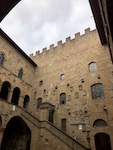
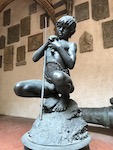
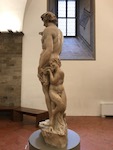

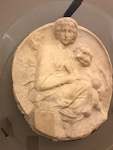

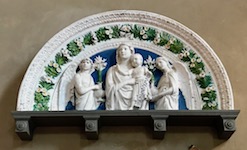
Now we stroll across the Ponte Vecchio again, past shops with glass storefronts through which we see wood working, metal, glass, jewelry and paper crafts in progress or on display. Back for our last time on the hotel roof garden, lazing and occasionally snacking, for hours, soaking up the amazing perspective from on high.
For our last night in Florence, Marisa has pre-purchased an opera event in the tiny, acoustically fabulous St. Mark's Anglican Church. Two female, two male singers, and one pianist. Highlights of La Boheme, costumes and props included, with very minimal set and lights. The four singers and the pianist are of such quality that we, who attend such things regularly, would be amazed were we to see them at the Lyric Opera in Chicago or the Met in New York.
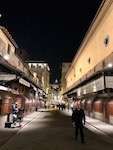
As with all stage performance, the most important facet of an individual's presentation is the flexibility to give the audience what it needs at a given moment to: 1) move the story along, 2) draw them in emotionally, 3) make them laugh or cry or want to and, most importantly, 4) make them forget themselves, right now. This ensemble does all of that, and the unforgettable moment flies by, giving us an unforgettable farewell from Florence, a world all its own, a home to all forms of treasured art.
We stroll back across the bridge again.
Slower.
Everything closed now.
Wednesday, 22 March
Quick bites at our terrific hotel, a short cab ride to the station, and away from Florence we slide, arriving at Santa Lucia station on the island of the city of Venice, taking just two hours.
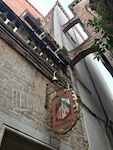

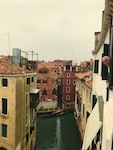
We had planned to try walking the half hour to our hotel, but clouds and the start of rain makes us change our minds, opting for the $70 water taxi (not a gondola.) Giving our bags to a man in uniform who walks all of 75 yards to the dock, we get on the taxi with our luggage, and the pilot says the porter wants 10 euro. First time we feel foolish about such treatment in this whole trip.
Landing at the dock a good distance from our hotel, we arrive there before the room is ready, which we expect, and we are pleased already with what we see. After a snack and a drink in the hotel, we are given our fourth floor, luxurious room with two windows overlooking the canal, the bridges and the moving gondolas with happy passengers.
After settling in, we begin to live our plan for the day: walk and shop and eat and walk and drink and shop and BE HERE. The city is the museum. The self-chosen stroll gives us exactly what we want, the walk-only city welcoming us to its unique atmosphere and vibe.
Our dinner is authentic Italian at Al Conte Pascaor, which our hotel concierge recommends when we ask for a seafood suggestion. Nice, long taste-filled meal.
To the hotel now we go, claiming for ourselves another forever memory.
Thursday, 23 March
Another breakfast and a stroll to St. Mark's Square, thinking about more museums; instead we stream through the cathedral in about fifteen minutes. The only priest we see is standing in the center of the pews shouting to the huge, ambling crowd, "No photos!" It works because "no" and "photo" are words that cross many languages. Amazing gold and glass mosaic in ceiling and wall illustrations of all that we are expecting from the Savior and his mom and dad.
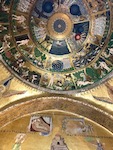
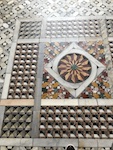
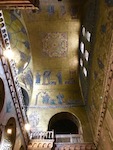
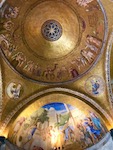
We get on a slow boat for a ride down the Grand Canal to the farthest landing -- the train station where we arrived -- then re-board and return to the Rialto landing, where we get off to walk through this museum of life named Venice. The streets have only shops, hotels, restaurants, churches and people on foot. No cars or delivery trucks, only men shouting a warning as they push outsized hand trucks from delivery boats to destinations. NO VESPAs !!!! Alleys that are four feet wide, often covered above. No honking horns or cursing drivers. We see how a person can get used to this. And when you do need to travel more quickly to work or play, you just get on the water and roll along.
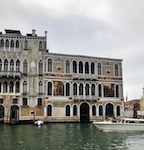
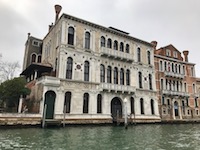

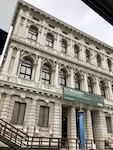
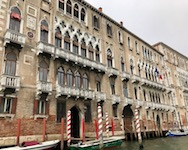
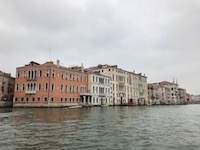
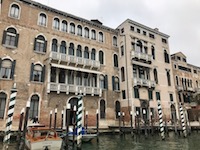
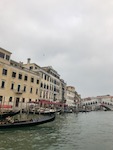

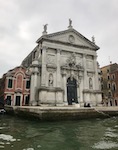
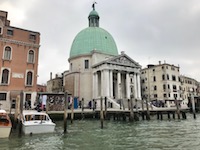
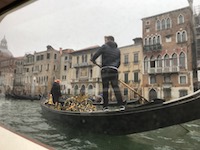
We have dinner of pizza and salad brought to the room by Wade, anticipating our Vivaldi concert coming at 8:30. We arrive to the intimate venue, which has only a few more seats than the Florence site that we loved. What an amazing experience this is: "The Four Seasons" composed by this native of Venice, originally performed in a space very similar in size and acoustics as where we now sit. The opening set is performed by two violins, one viola (female), one cello, one bass and the harpsichord. They produce an amazingly big sound with complete intersection of narrative lines among instruments. Beautiful. Following a short intermission, the six musicians we just heard return, joined by a Finnish young woman with her violin. She takes over as the lead violinist, standing and leading the group for the rest of the concert, all of "Four Seasons," plus an encore.
Flawless. Full sound. Beautiful setting for us, the audience. Another unexpected, completely winning experience.
Friday, 24 March
We have a mid-morning departure, so our morning is easy. We amble through foggy San Marco, then a canal shuttle to the airport. Not cheap, but completely right for the goodbye to Venice and to Italy.
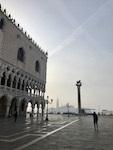
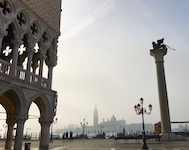
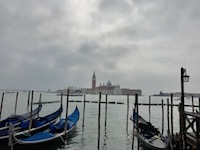
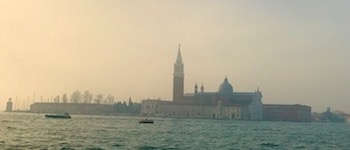
The big boot of the Mediterranean kicked us in a good way, giving us the jolt of new experience and the humility that comes with genuine awe. The Italian people, and the visitors we encountered from around the world, are better citizens as a result of the constant contact. We take that reaffirmed certainty home with us, energized yet again by getting out of our oddly isolated nation one more time.
VENI, VIDI et VIDI, et VIDI, et VIDI . . . !